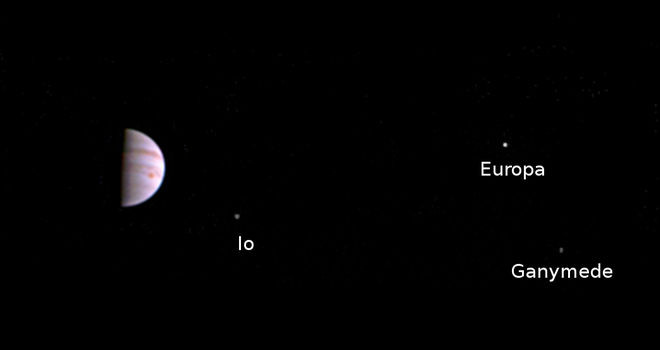Nasa's Juno probe sends back first image of Jupiter's moons via 'JunoCam'
The image shows the sunlit part of the planet and three of its four moons.
The Juno mission to Jupiter, which launched in 2011, has sent back its first image since the spacecraft entered the orbit of the Solar System's largest planet on 4 July.
Nasa released the image taken by the "JunoCam" camera of a sunlit portion of the gas giant flanked by three of its big moons, Io, Europa and Ganymede, although its fourth major moon, Callisto, is not in shot.
The image was taken on Sunday 10 July when the spacecraft was 4.3 million km from Jupiter, some six days after the craft managed to get into orbit around the planet in what has been termed the toughest technical task that Nasa has ever performed. The image showed the planet's renowned red spot, as well as its coloured bands.
Scott Bolton, from the Southwest Research Institute in San Antonio, said: "This scene from JunoCam indicates it survived its first pass through Jupiter's extreme radiation environment without any degradation and is ready to take on Jupiter.
"We can't wait to see the first view of Jupiter's poles," he added, according to Nasa.

JunoCam will continue to capture images, with the first high-resolution shots of the planet due to be taken on 27 August, when Juno makes its next close pass to Jupiter.
As Nasa states, the mission team are checking all the probe's instruments and, in mid-October, an engine burn will put the spacecraft in a tight, 14-day orbit around the planet, when its study by scientists will begin in earnest.
Juno will circle Jupiter 37 times and will pass as close as 2,600 miles (4,100 km) above its clouds to find out about the planet's deep interior and how the gas giant formed. Juno is scheduled to end it's mission in 2018, where it will dive into Jupiter's atmosphere and disintegrate.
© Copyright IBTimes 2025. All rights reserved.






















